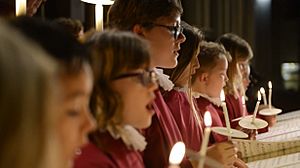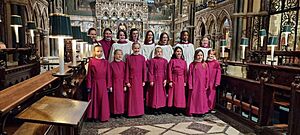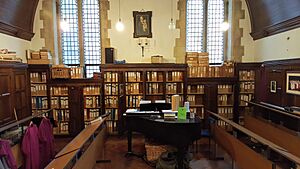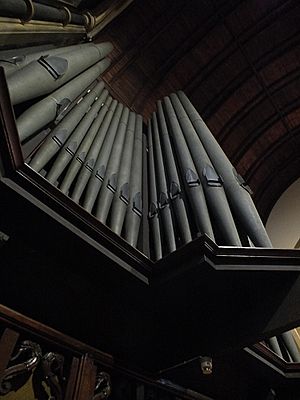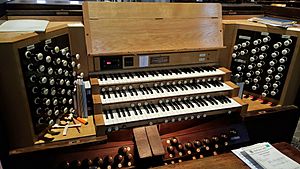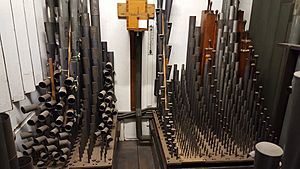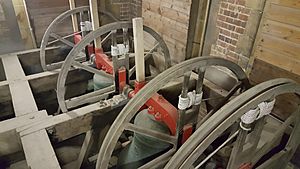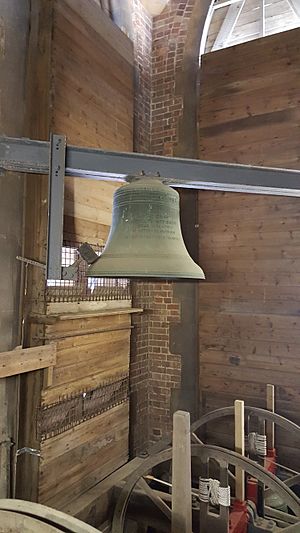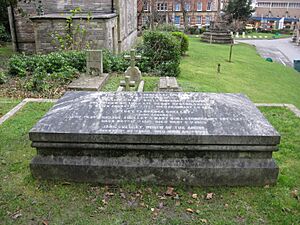St Peter's Church, Bournemouth facts for kids
Quick facts for kids St Peter's Church, Bournemouth |
|
|---|---|
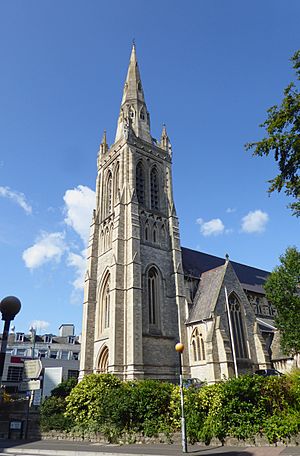 |
|
| 50°43′14″N 1°52′32″W / 50.7205°N 1.8755°W | |
| Denomination | Church of England |
| Churchmanship | Liberal Catholic |
| History | |
| Status | Parish Church |
| Dedication | Saint Peter |
| Architecture | |
| Architect(s) | G. E. Street |
| Style | Gothic Revival |
| Completed | 1879 |
| Specifications | |
| Height | Spire 202 feet (62 m) |
| Floor area | 12,658 square feet (1,176.0 m2) |
| Materials | Purbeck stone with Bath stone dressings |
| Administration | |
| Parish | Bournemouth |
| Deanery | Bournemouth |
| Archdeaconry | Bournemouth |
| Diocese | Winchester |
| Province | Canterbury |
St Peter's Church is a beautiful Church of England parish church right in the heart of Bournemouth, England. It's a very important building, listed as Grade I, which means it's super special! The church was finished in 1879 and was designed by George Edmund Street. It was the very first main church for Bournemouth.
This church has amazing artwork and designs by some of the best Gothic Revival artists and architects. These include Street himself, George Frederick Bodley, Ninian Comper, Arthur Blomfield, and Edward Burne-Jones. You can see beautiful stained-glass windows and paintings by Clayton and Bell. The part of the church where the altar is, called the chancel, is known as one of the most richly decorated Gothic Revival interiors in England. The tall spire, which is about 61 meters (202 feet) high, is a famous landmark in Bournemouth town centre.
Did you know that Mary Shelley, who wrote the famous book Frankenstein, is buried here? People also say that the heart of her husband, the poet Percy Bysshe Shelley, is buried with her.
Contents
History of St Peter's Church
St Peter's Church was built over 24 years, starting in 1855. The idea came from the first vicar of Bournemouth, Reverend Alexander Morden Bennett. He wanted to replace an older church building. G. E. Street was chosen to design a grander church that would fit the beauty of the growing town.
The church was built in different stages because it was too expensive to build all at once. Each part was paid for by donations from the public.
- In 1855, the north aisle (a side section) was added to the old church.
- In 1859, a new roof and upper windows (clerestory) were built over the old church.
- From 1863 to 1864, the chancel (the area around the altar), eastern transepts (side arms of the church), and vestries (rooms for clergy) were built.
- Between 1869 and 1870, the 35-meter (116-foot) tall tower was constructed.
- In 1874, the tower was connected to the main part of the church (the nave) by adding a narthex (entrance area) and western transepts.
- Finally, in 1879, the 26-meter (86-foot) spire was added to the tower, completing Street's original design.
Later, in 1914, an extension was added to the church. This new part included a vestry, an office, and a special room for the choir to practice, called a song school. It also had a basement area with a kitchen and toilets.
In 1926, the Chapel of the Resurrection was built in the churchyard. It was designed by Ninian Comper and was meant to be a memorial chapel for those who died in World War I. This chapel was updated in 2014 with a kitchen, toilet, and heating.
St Peter's Church Today
St Peter's Church is still an active parish church today. It is part of the Diocese of Winchester and follows a Liberal Catholic style within the Church of England. It remains the main parish church for Bournemouth town centre.
The church is an important historical place in the town. Many notable people are buried here. It's also a welcoming community space. People can visit, walk around, and enjoy the peaceful atmosphere. There's a community cafe called Parry's, which is open from Wednesday to Friday. The church also hosts free music and performances.
In the summer of 2020, a project called "Grounds Reimagined" started. It aimed to clear and improve the nearly 4-acre woodland churchyard, which had been neglected for many years. This project received help from local councils and wildlife groups. Now, there are special trails for wildlife and history, highlighting important graves for visitors to explore. This project brought together church members, other groups, and local residents.
More recently, in the summer of 2023, the church's tower and spire were repaired. This big renovation was partly paid for by grants from the National Churches Trust and the Wolfson Foundation.
Church Leaders
Since November 2024, the main priest for Bournemouth Town Centre Parish has been the Reverend Canon Nicholas Jepson-Biddle. He used to be a leader at Wells Cathedral.
Past Vicars and Rectors
Here are some of the important leaders who have served St Peter's Church over the years:
- 1845 – Alexander Morden Bennett
- 1880 – Vincent William Ryan
- 1881 – George Stopford Ram
- 1890 – Cecil Edward Fisher
- 1904 – Alfred Edward Daldy
- 1921 – Lumley Cecil Green-Wilkinson
- 1927 – Hubert Henry Lovatt Lloyd Marsh
- 1936 – Hedley Robert Burrows
- 1944 – Norman Robert Boyd
- 1946 – Anthony Lewis Elliott Williams
- 1957 – Wilfred Henry Fox-Robinson
- 1967 – Colin Clement Walter James
Rectors of Bournemouth Town Centre Parish
- 1973 – Arthur Colin Bouverie Deedes
- 1980 – Dick Heath Remi Jones
- 1996 – James John Richardson
- 2009 – Ian Andrew Terry
- 2024 – Nicholas Jepson-Biddle
Music at St Peter's
Music is a very important part of St Peter's Church, especially the choir.
Choirs
History of the Choir
St Peter's has always had a strong tradition of choral music. In 1865, a "Choir Home" was started. Eight of the 18 boy choristers lived there, while the other ten lived in town. All the choristers went to St Peter's School, which was next to the church. The choir sang at services every day and four times on Sundays.
As Bournemouth grew, there was no longer a need for the Choir Home, and it closed in 1924. St Peter's School also closed in 1935. The choir continued to grow with men and boys throughout the 20th century. A girls' section of the choir was added in 2009.
The Choir Today
Today, the choir has boy choristers, girl choristers, and adult singers. They provide music for two services every Sunday and on special feast days during school terms. The boys and girls usually sing separately but join together for big events like Christmas and Easter. The choir has also sung in many famous cathedrals and churches across Britain and sometimes makes recordings.
The choir practices in the song school, a special room built in 1914. It has a unique barrel-shaped roof, a piano, and storage for music and robes. The St. Peter's Choral Foundation was created in 2021 to help support the choir's activities.
Organs
St Peter's Church has had several organs over the years.
Early Organs (1843–1870)
The very first organ was built in 1843 for the opening of the church's earlier building. It was moved around as the new church was built. Later, a second-hand organ from London was used temporarily. This organ was described as "ugly-looking" and not powerful enough for the new, larger church.
The Willis Organ (1870–1914)
In 1869, a famous organ builder named Henry Willis was asked to build a new organ. This organ had 24 stops and 1292 pipes. It was placed in a special chamber next to the sanctuary and was decorated with colorful patterns. This organ was used until 1912, when it was decided that it was too old and worn out.
The Harrison Organ (1914 to Present)
In 1913, the church decided to get a much larger and newer organ. They hired Harrison and Harrison to build it. This new organ has 48 stops and uses some of the pipes from the old Willis organ. It cost over £2700 to build. The organ was placed in a new chamber where the old vestries used to be.
A special wooden case for the organ was designed, but it was never built because it was too expensive. In 1976, the organ was updated, making it even larger with 54 stops. A movable console (the part where the organist plays) was added to the front of the church. The organ is now over 100 years old and needs a full update.
Organists
Many talented organists have played at St Peter's Church:
- 1859 – J. H. Caseley
- 1868? – Mr. Taylor
- 1869 – Thomas Burton
- 1880 – Duncan Hume
- 1905 – James Chandler
- 1946 – Charles Palmer
- 1953 – Michael Peterson
- 1966 – Harry Sayles
- 1967 – Frederick Hewitt
- 1968 – Cyril Knight
- 1971 – John Belcher
- 1981 – Martin Firth
- 1985 – Stephen Carleston
- 1993 – David Beeby
- 2002 – Charles Spanner
- 2003 – Ben Lamb
- 2007 – Stephen Le Prevost
- 2008 – David Coram
- 2011 – Sam Hanson
- 2015 – Duncan Courts
Church Bells
St Peter's has the heaviest set of bells in Bournemouth! It was the first church in town to have a full set of bells. There are eight bells that can be rung in a special English style called change ringing, and also a smaller Sanctus bell that can be chimed from inside the church.
When the tower was finished in 1870, it was planned to have bells. When the first priest, Morden Bennett, became ill, people in the church and town raised money for six more bells to honor him. The bells were made by John Taylor & Co and were first rung in 1871.
In 1936, it was suggested that the bells be re-hung and re-tuned, and a new Sanctus bell added. This was to be a memorial to Alfred Daldy, a previous church leader. It was found that the old bells were in poor condition. So, Taylor's re-cast all the bells, making them even better. The new bells were dedicated on November 20, 1937.
| Number | Date | Note | Maker | Mass | ||
|---|---|---|---|---|---|---|
| long measure | lb | kg | ||||
| 1 | 1937 | E | John Taylor & Co | 5 long cwt 0 qr 2 lb | 562 | 255 |
| 2 | 1937 | D# | John Taylor & Co | 5 long cwt 2 qr 0 lb | 616 | 279 |
| 3 | 1937 | C# | John Taylor & Co | 5 long cwt 3 qr 13 lb | 657 | 298 |
| 4 | 1937 | B | John Taylor & Co | 7 long cwt 1 qr 3 lb | 815 | 370 |
| 5 | 1937 | A | John Taylor & Co | 9 long cwt 1 qr 8 lb | 1,044 | 474 |
| 6 | 1937 | G# | John Taylor & Co | 10 long cwt 3 qr 18 lb | 1,222 | 554 |
| 7 | 1937 | F# | John Taylor & Co | 15 long cwt 0 qr 2 lb | 1,682 | 763 |
| 8 | 1937 | E | John Taylor & Co | 20 long cwt 2 qr 7 lb | 2,303 | 1,045 |
| Sanctus | 1937 | G | John Taylor & Co | 9 long cwt 2 qr 25 lb | 1,089 | 494 |
Famous People Connected to St Peter's
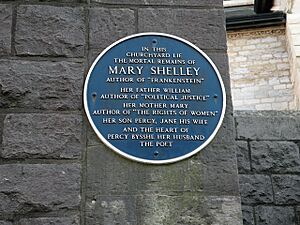
St Peter's Church has connections to many famous people:
- William Ewart Gladstone, who was the British Prime Minister four times, took his last communion here in 1898.
- The composer Sir Hubert Parry was born in this area in 1848. His mother was buried in the churchyard, and Hubert was baptised in the church.
- John Keble, an important church leader, died in the parish in 1866. There are two stained-glass windows in the church dedicated to him, and a special chapel, the Keble Chapel, was named in his memory.
- Sir Dan Godfrey, who started the Bournemouth Symphony Orchestra in 1896, is buried here.
- Major General Richard Clement Moody, who was a governor in the Falkland Islands and British Columbia, is also buried here.
- Alma Rattenbury, a songwriter, is buried here.
- Lewis Tregonwell, who founded Bournemouth, bought land here in 1810 and built a house that is now part of the Royal Exeter Hotel.
- Mary Shelley, the author of Frankenstein, is buried here. It's believed that the heart of her husband, the poet Percy Bysshe Shelley, is buried with her. Their son, Sir Percy Shelley, moved his mother and her parents, Mary Wollstonecraft and William Godwin, to be buried together in Bournemouth.
- More recently, the funeral of radio DJ and TV presenter Ed Stewart was held in the church in 2016.
Images for kids


